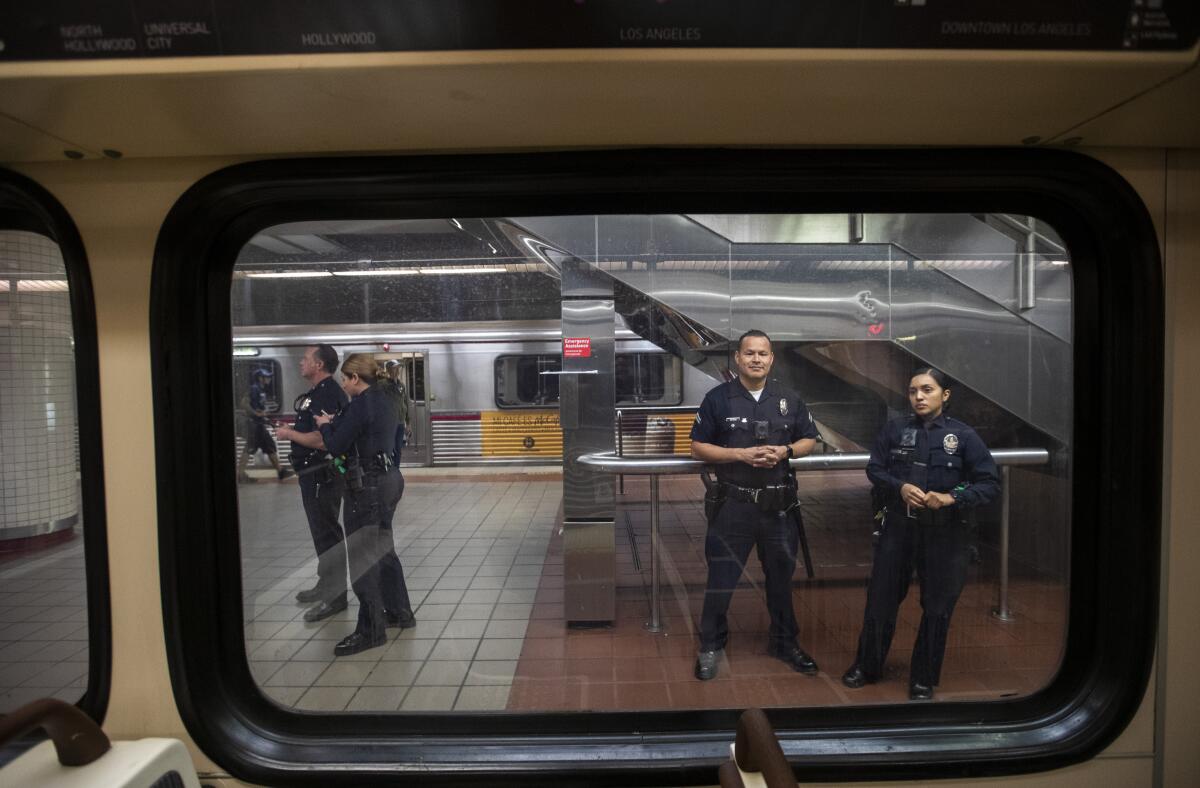There are ways to make riding Metro safe with fewer police officers

- Share via
Four years ago, Metro was facing a serious problem. Voters overwhelmingly passed the Measure M sales tax measure to expand transit service, and the agency hoped to triple ridership. But the number of people actually riding the buses and trains was falling. And in surveys and forums, passengers and would-be passengers repeatedly expressed the same concern: They were scared to ride public transit.
In response, Metro’s governing board voted to dramatically increase spending on policing, splitting the responsibilities among the Los Angeles County Sheriff’s Department and the Los Angeles and Long Beach police departments. That move nearly doubled the number of armed officers on the system.
Today, however, there’s a very different conversation happening at Los Angeles County’s transportation agency. Following weeks of protests over police brutality and racial injustice, Metro’s governing board will vote Thursday on a proposal to begin replacing law enforcement officers with homelessness outreach workers, mental health professionals, transit “ambassadors” and other unarmed service providers.
If approved, Metro would be expected to develop a new approach to public safety before 2022, when the current contracts with police agencies expire.
Los Angeles City Councilman Mike Bonin said the proposal is partly a response to long-standing complaints of racial bias in the policing of the system, particularly from young Black and Latino riders. They often have a very different perception of and relationship with law enforcement, and they may not feel safer when an armed officer steps on their bus or train.
The proposal is also part of a now-nationwide effort by Black Lives Matter and other activists to force government agencies — from city councils to school boards to transit agencies — to rethink public safety.
It’s an overdue assessment.
For years, police have been the default solution to any public safety issue. But even many police officers would agree that they are not the right people to respond to societal issues that aren’t primarily matters of public safety, from mental health crises to subway fare evaders. Now, there’s a broader recognition that the mere presence of an armed law enforcement officer can inflame a situation or turn it deadly.
But Metro has a particular challenge. The success of public transit — and the willingness of people to ride a bus or train — depends on passengers feeling safe and secure. Several years ago, almost 30% of the former riders surveyed said they left the system because they did not feel safe. Respondents said the lack of security was a bigger deterrent to using transit than speed, reliability and accessibility.
The fear was particularly strong among women, and for good reason. Nearly 30% of women passengers surveyed said they had experienced sexual harassment on the system. Just 20% said they felt safe riding Metro at night. Last year, in a report on how women use the transit system, more than half of the women surveyed said there were not enough officers patrolling the system.
Metro leaders said violent and serious crime on the system has decreased 17% since the agency ramped up the police presence and hired more security guards. At the same time, Metro leaders argue they’ve tried to adopt a less confrontational, more community-oriented policing model, including having unarmed guards — not police officers — check fares and issue $75 administrative citations rather than misdemeanor charges.
The agency has also contracted with social service agencies to have homelessness, mental health and substance abuse specialists respond to nonviolent incidents. That’s a good model, and it should be expanded.
Metro cannot and should not eliminate law enforcement officers from its transit system. There are still violent incidents on the region’s buses and trains, and you need a cop on the scene quickly in a dangerous situation. Every week there are two to three assaults on bus drivers, from getting spat on to punched, the agency says.
But Metro, like all agencies, should use this moment to rethink how it ensures public safety. It’s clear that riders want security on transit. The questions are who should provide it and how Metro can make all passengers feel safer.
More to Read
A cure for the common opinion
Get thought-provoking perspectives with our weekly newsletter.
You may occasionally receive promotional content from the Los Angeles Times.









